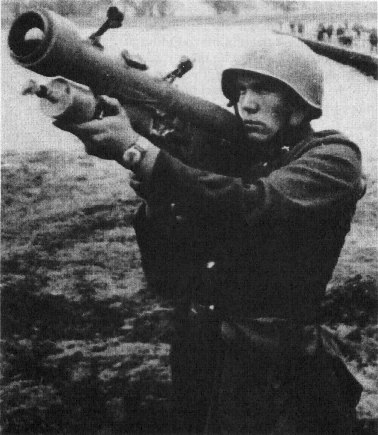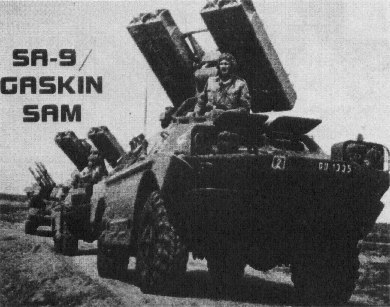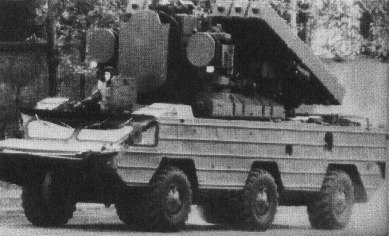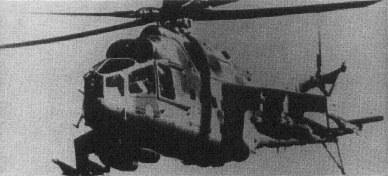Gunship Academy
by Richard Sheffield
Soviet Weapons
Air Defense Systems. The Soviet doctrine regarding air defense is no secret. They are expected to adhere strongly to the four basic principles of antiaircraft coverage: mass, mix, mobility, and integration.
Mass. The Soviets will bring to bear as many weapons as possible in the air defense (AD) role. This will include an enormous amount of small-arms fire. The greater the number of projectiles that can be thrown at an aircraft, the greater the probability that a hit will be scored. At the least, the crew will be distracted and may abort the mission.
Mix. Every AD system has its limitations and vulnerabilities. When AA guns and missiles are employed together, the limitations of each are offset by the other. Countermeasures used to defeat one system will rarely fool the other.
Mobility. Mobility serves two functions for an AD system. First, as the force moves forward with the advancing battle, the AD systems can move with them. Secondly, air defense systems which remain in the same position for extended periods of time are subject to being located by the enemy and targeted for destruction. A constantly moving target is much harder to pinpoint and eliminate.
Integration. Integration can be achieved by locating the AD systems throughout the area to be defended, from the front lines to the rear areas, thus providing defense in depth.
The Syrian and Egyptian forces learned a harsh lesson in these four principles during the Six Day War of 1967. Prior to the war, their entire AD system consisted of 150 SA-2 missiles and a number of 57mm AA guns. All of these weapons were located in fixed sites. With the outbreak of the war, the Israelis launched a strike against the enemy airfields and AA sites. In one attack, they destroyed 380 of the Arabs' 500 aircraft and 60 percent of the Arab ground forces.
Upon examination, it is clear that the Arabs did not follow even one of the four principles of air defense: With very few weapons, mass was not achieved; only two weapons do not make for a proper mix; the units were certainly not mobile; and with all of the AD located in a single belt, there was no defense in depth. When war broke out again in 1973, the Arab forces were much better equipped and trained.
Air Defense Weapons. Soviet antiaircraft firepower includes a variety of mobile guns, missiles, and the Hind helicopter.
SA-7 and SA-14 Grail. The Grail is a man-portable, shoulder-fired, heat-seeking, surface-to-air missile. The operator points the missile in the direction of the target, applies half-trigger, and observes the internal light. When this light turns from red to green it is locked onto the target. Full trigger is then applied, and the missile is fired.
Like U.S. Army shoulder-fired missiles, the SA-7 and the SA-14 have a short-burn boost stage which burns out before the missile leaves the tube. Once the missile is a safe distance from the operator, the main engine ignites and powers the missile to the target.
The missile itself uses passive infrared (IR) homing guidance. It is attracted to the heat produced by your aircraft. The basic SA-7 has an unsophisticated tracking system that is easily fooled by flares. The SA-7B has an improved guidance system with an IR filter to screen out these decoys. The new SA-14 has an even better guidance system and is reported to contain a larger warhead.
Warhead size has always been the main weakness of the SA-7 series. Due to its small size, even direct target hits were not always fatal. During the Yom Kippur Middle East war, over half of the Israeli A-4s hit by SA-7s were able to safely return to base.
These missiles will be found throughout the Soviet-controlled areas. They will move forward with infantry and motorized rifle divisions equipped with BMPs (Boevaya Mashina Peknota, a type of infantry fighting vehicle). They are also used against low-flying aircraft as a close-in defense weapon around rear headquarters and supply areas. It's likely that you'll encounter SA-7s and/or SA-14s at numerous locations during your missions.

ZSU-23-4 Shilka. The second line of air defense follows closely behind the fast-moving infantry and BMPs. This line consists of the much feared ZSU-23-4 Shilka mobile AA gun. The Shilka, or zoo as U.S. soldiers call it, is a rapid-firing AA cannon with four liquid-cooled 23mm barrels. The system is aimed via computerized radar fire control and is mounted on the PT-76 light-tank chassis.
The reported practical rate of fire is 200 rounds per minute per barrel, fired in 50-round bursts. They can also fire while on the move. The main weakness of the system is the relatively light armor on the turret; the thin armor plating can be penetrated by machine gun fire. Zoos are usually employed in pairs located fairly close together (200–400 meters).
SA-9 Gaskin Missile. In the same general area as the ZSU-23-4, you might also find SA-9 missiles. They would normally be located a kilometer or so behind the zoos to provide forward and rear area coverage. The SA-9 system consists of a light-armored vehicle (wheeled—not tracked and not amphibious) to which fow SA-9 launchers are attached on a rotating mount. The SA-9 missile is very similar to the shoulder-fired SA-7. They are heat-seeking with a small warhead, though the SA-9 djpes have a longer range than the SA-7. Since there is no onboard fire control with the SA-9, the target must be visually acquired by the operator.
SA-8 Gecko Missile. In forward and rear areas of well-equipped, front-line Soviet and Soviet-backed forces, you will also run into SA-8 missiles. The SA-8 system uses a six-wheeled light-armored vehicle to carry a quad launcher for the SA-8 missiles. This system features multiple tracking methods. The main system consists of a large tracking radar for locating targets and two missile guidance radars which can operate independently. This allows two missiles to be fired at once. Once close to the target, the radar control hands off to an IR-seeking system for final maneuvering. If both of those systems are fooled, it also has an onboard visual TV-guidance system. Besides the four missiles carried in the launchers, it's believed that they also carry eight more missiles internally, enough for two complete reloads. As these weapons become more available, it's likely that they'll replace the S-60 AA gun in the rear-area air defense role.

SA-11 Gadfly Missile. First-line Soviet troops will likely also have the SA-11 system as a backstop behind the forward lines. The missile itself is very similar to the older SA-6. The problem with the SA-6 was that all the vehicle launchers were tied to a single radar controller. The SA-11 system allows each TELAR (Transporter Erector Launcher And Radar) to act independently by fitting each with its own radar system. Since this system no longer needs to be bunched together, this weapon may show up in all areas of the battlefield.

SA-13 Gopher Missile. Another weapon likely to be found only with first-line troops is the SA-13. This missile is basically a new and improved version of the SA-9. The Gopher sports a new cryogenically cooled IR seeker which makes it the most sensitive heat-seeking weapon in the Soviet arsenal. This device also operates in two frequency bands, making it much less susceptible to countermeasures. The SA-13s are mounted on a modified MT-LB tracked chassis which gives them much-improved mobility over the SA-9s they were designed to replace. This chassis gives the system cross-country maneuverability comparable to the BMP-equipped motorized rifle groups they are supposed to protect.
S-60 Towed AA Gun. The S-60 is an old but effective 57mm rear-area Air Defense weapon. This gun is generally aimed and fired optically, but more modern versions featuring long-range search radar and radar fire control are available to better-equipped forces.

Mi-24 Hind Helicopter. The use of the helicopter as an air defense weapon is a fairly recent development and is still undergoing constant change. Currently, the aircraft most likely to be faced by U.S. pilots is the multipurpose Mi-24 Hind, although plans are thought to be underway for a pure fighter helicopter more suited for the air-to-air role.
The Hind is powered by two turbo-shaft engines, each of which produce 2200 horsepower and are armor protected. This power enables the Hind to carry 3330 pounds of fuel, 3200 pounds of arms, and a ton of armor at speeds close to 200 mph. The sheer size of the Hind is its main liability. It's easier to spot at a distance than the narrower and smaller U.S. attack helicopters and not nearly as maneuverable. The Soviets counter this problem by producing large numbers of these aircraft (as many as 1500 may have been built) and by constantly improving their tactics.

Table of Contents
Previous Section: AH-64A Apache Armament
Next Section: Basic Helicopter Flight Training
